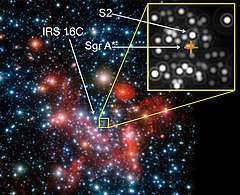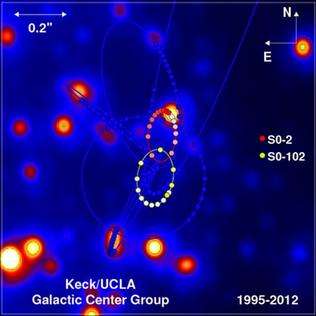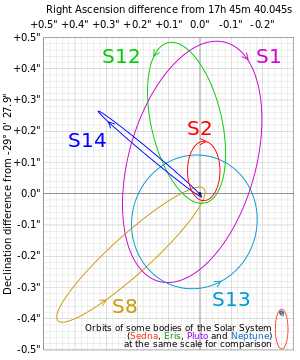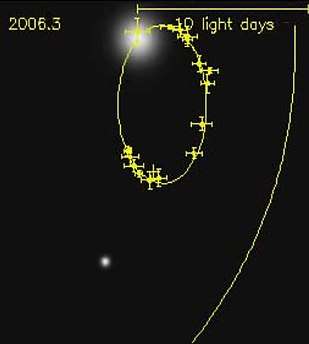S2 (star)
 Image of the galactic centre showing the position of S2 Credit: ESO/MPE/S. Gillessen et al. | |
| Observation data Epoch J2000.0 Equinox J2000.0 (ICRS) | |
|---|---|
| Constellation | Sagittarius |
| Right ascension | 17h 45m 40.0442s[1] |
| Declination | −29° 00′ 27.975″[1] |
| Characteristics | |
| Spectral type | B0-2 V[2] |
| Astrometry | |
| Distance | 7,940±420[3] pc |
| Orbit[3] | |
| Companion | Sagittarius A* |
| Period (P) | 16.0518[4] yr |
| Semi-major axis (a) | 0.12540 ± 0.00018″ |
| Eccentricity (e) | 0.88466 ± 0.00018 |
| Inclination (i) | 133.818 ± 0.093° |
| Longitude of the node (Ω) | 227.85 ± 0.19° |
| Periastron epoch (T) | 2018.37974 ± 0.00015 |
| Argument of periastron (ω) (secondary) | 66.13 ± 0.12° |
| Other designations | |
[CRG2004] 13, [GKM98] S0-2, [PGM2006] E1, [EG97] S2, [GPE2000] 0.15, [SOG2003] 1, S0—2. | |
| Database references | |
| SIMBAD | data |
S2, also known as S0–2, is a star that is located close to the radio source Sagittarius A*, orbiting it with an orbital period of 16.0518 years, a semi-major axis of about 970 au, and a pericenter distance of 17 light hours (18 Tm or 120 au) – an orbit with a period only about 30% longer than that of Jupiter around the Sun, but coming no closer than about four times the distance of Neptune from the Sun. The mass when the star first formed is estimated by the European Southern Observatory (ESO) to have been approximately 14 M☉.[5] Based on its spectral type, it probably has a mass of 10-15 solar masses.
Its changing apparent position has been monitored since 1995 by two groups (at UCLA and at the Max Planck Institute for Extraterrestrial Physics) as part of an effort to gather evidence for the existence of a supermassive black hole in the center of the Milky Way galaxy. The accumulating evidence points to Sagittarius A* as being the site of such a black hole. By 2008, S2 had been observed for one complete orbit.[6]
A team of astronomers mainly from the Max Planck Institute for Extraterrestrial Physics used observations of S2's orbital dynamics around Sgr A* to measure the distance from the Earth to the galactic center. They determined the distance to be 7.94 ± 0.42 kiloparsecs, in close agreement with prior determinations of the distance by other methods.[3][7]
S2 was precisely tracked during its May 2018 close approach to Sagittarius A*, with results in accord with general relativity predictions.
Etymology
The designation S0-2 was first used in 1998. S0 indicates a star within one arc-second of Sagittarius A*, indicating the galactic centre, and S0-2 was the second closest star seen at the time of the measurements.[8] The star had been catalogued simply as S2 a year earlier, the second of eleven infrared sources near the galactic centre, numbered approximately anti-clockwise.[9] It is a coincidence that the star received the number two in both lists, and other sources have different numbers.[8]
Orbit
The highly eccentric orbit of S2 will give astronomers an opportunity to test for various effects predicted by general relativity and even extra-dimensional effects.[10] These effects reached a maximum at closest approach, which occurred in mid-2018.[11][12] Given a recent estimate of 4.31 million M☉ for the mass of the Sagittarius A* black hole and S2's close approach, this makes S2 the fastest known ballistic orbit, reaching speeds exceeding 5,000 km/s (11,000,000 mph, or 1/60 the speed of light) and acceleration of about 1.5 m/s2 (almost one-sixth of Earth's surface gravity).[13]
The motion of S2 is also useful for detecting the presence of other objects near to Sagittarius A*. It is believed that there are thousands of stars, as well as dark stellar remnants (stellar black holes, neutron stars, white dwarfs) distributed in the volume through which S2 moves. These objects will perturb S2's orbit, causing it to deviate gradually from the Keplerian ellipse that characterizes motion around a single point mass.[14] So far, the strongest constraint that can be placed on these remnants is that their total mass comprises less than one percent of the mass of the supermassive black hole.[15]
May 2018 pericentre passage
In July 2018, Reinhard Genzel et al reported[16][17] that S2 had been recorded at 7,650km/s or 2.55% the speed of light leading up to the pericentre approach in May 2018 at about 120 AU ≈ 1400 Schwarzschild radii from Sgr A*. This allowed them to assert from the discernible redshift at relativistic velocities that general relativity, in particular, gravitational redshift, is confirmed.
S0–102
In 2012, a star called S0–102 was found to be orbiting even closer to the Milky Way's central supermassive black hole than does S0-2. At one-sixteenth the brightness of S0-2, S0-102 was not initially recognized because it required many more years of observations to distinguish it from its local infrared background. S0-102 has an orbital period of 11.5 years, even shorter than that of S0-2. Of all the stars orbiting the black hole, only these two have their orbital parameters and trajectories fully known in all three dimensions of space.[18] The discovery of two stars orbiting the central black hole so closely with their orbits fully described is of extreme interest to astronomers, as the pair together will allow much more precise measurements on the nature of gravity and general relativity around the black hole than would be possible from using S0-2 alone.
Gallery
 Artist’s annotation of S2 passing supermassive black hole at center of Milky Way, confirming gravitational red shift[19]
Artist’s annotation of S2 passing supermassive black hole at center of Milky Way, confirming gravitational red shift[19] Orbits of S0-2 and S0-102 around the Milky Way galaxy's supermassive black hole
Orbits of S0-2 and S0-102 around the Milky Way galaxy's supermassive black hole Inferred orbits of S2 and 5 other stars around supermassive black hole candidate Sagittarius A* at the Milky Way galactic centre[20]
Inferred orbits of S2 and 5 other stars around supermassive black hole candidate Sagittarius A* at the Milky Way galactic centre[20] Observations showing the discovery of the orbit of S2 about the galactic centre
Observations showing the discovery of the orbit of S2 about the galactic centre
References
- 1 2 Schödel, R; Merritt, D; Eckart, A (2009). "The nuclear star cluster of the Milky Way: Proper motions and mass". Astronomy & Astrophysics. 502: 91–111. arXiv:0902.3892. Bibcode:2009A&A...502...91S. doi:10.1051/0004-6361/200810922.
- ↑ Paumard, T; Genzel, R; Martins, F; Nayakshin, S; Beloborodov, A. M; Levin, Y; Trippe, S; Eisenhauer, F; Ott, T; Gillessen, S; Abuter, R; Cuadra, J; Alexander, T; Sternberg, A (2006). "The Two Young Star Disks in the Central Parsec of the Galaxy: Properties, Dynamics, and Formation". The Astrophysical Journal. 643 (2): 1011–1035. arXiv:astro-ph/0601268. Bibcode:2006ApJ...643.1011P. doi:10.1086/503273.
- 1 2 3 Eisenhauer, F.; et al. (2003). "A Geometric Determination of the Distance to the Galactic Center". The Astrophysical Journal. 597 (2): L121–L124. arXiv:astro-ph/0306220. Bibcode:2003ApJ...597L.121E. doi:10.1086/380188.
- ↑ Hees, A. (2017). "Testing General Relativity with Stellar Orbits around the Supermassive Black Hole in Our Galactic Center". Physical Review Letters. 118 (21). doi:10.1103/PhysRevLett.118.211101.
- ↑ Habibi, M.; et al. (2009). "Twelve Years of Spectroscopic Monitoring in the Galactic Center: The Closest Look at S-stars near the Black Hole". The Astrophysical Journal. 847 (2): 120. arXiv:1708.06353. Bibcode:2017ApJ...847..120H. doi:10.3847/1538-4357/aa876f.
- ↑ A short documentary on Sagittarius A* on YouTube
- ↑ Max-Planck-Institut für extraterrestrische Physik—Infrared/Submillimeter Astronomy—Galactic Center Research
- 1 2 Ghez, A. M; Klein, B. L; Morris, M; Becklin, E. E (1998). "High Proper‐Motion Stars in the Vicinity of Sagittarius A*: Evidence for a Supermassive Black Hole at the Center of Our Galaxy". The Astrophysical Journal. 509 (2): 678–686. arXiv:astro-ph/9807210. Bibcode:1998ApJ...509..678G. doi:10.1086/306528.
- ↑ Eckart, A; Genzel, R (1997). "Stellar proper motions in the central 0.1 pc of the Galaxy". Monthly Notices of the Royal Astronomical Society. 284 (3): 576–598. Bibcode:1997MNRAS.284..576E. doi:10.1093/mnras/284.3.576.
- ↑ Black Hole as Peephole
- ↑ Ghez, Andrea M. (speaker) (19 April 2016). Black Holes @ 100 Workshop: Galactic Center (Lecture). Harvard University: Black Hole Initiative. Remarks beginning at 31:55.
...we are '2018 or bust' these days, because at that moment your orbital determination becomes so much better.
- ↑ http://www.syfy.com/syfywire/a-star-is-about-to-plunge-head-first-toward-a-monster-black-hole-astronomers-are-ready-to
- ↑ Surfing a Black Hole
- ↑ Sabha, Nadeen; Eckart, Andreas; Merritt, David; Mohammad Zamaninasab; Gunther Witzel; Macarena García-Marín; Behrang Jalali; Monica Valencia-S.; et al. (September 2012). "The S-Star Cluster at the Center of the Milky Way: On the nature of diffuse NIR emission in the inner tenth of a parsec". Astronomy and Astrophysics. 545: A70. arXiv:1203.2625. Bibcode:2012A&A...545A..70S. doi:10.1051/0004-6361/201219203.
- ↑ Gillessen, S.; et al. (2009). "Monitoring Stellar Orbits Around the Massive Black Hole in the Galactic Center". The Astrophysical Journal. 692 (2): 1075–1109. arXiv:0810.4674. Bibcode:2009ApJ...692.1075G. doi:10.1088/0004-637X/692/2/1075.
- ↑ Detection of the gravitational redshift in the orbit of the star S2 near the Galactic centre massive black hole, Genzel et al, Astronomy & Astrophysics, DOI doi:10.1051/0004-6361/201833718, 2018-07-26
- ↑ Star spotted speeding near black hole at centre of Milky Way -- Chile’s Very Large Telescope tracks S2 star as it reaches mind-boggling speeds by supermassive black hole, The Guardian, 2017-07-26
- ↑ Meyer, L.; Ghez, A. M.; Schödel, R.; Yelda, S.; Boehle, A.; Lu, J. R.; Do, T.; Morris, M. R.; Becklin, E. E.; Matthews, K. (2012). "The Shortest-Known-Period Star Orbiting Our Galaxy's Supermassive Black Hole". Science. 338 (6103): 84–87. arXiv:1210.1294. Bibcode:2012Sci...338...84M. doi:10.1126/science.1225506. PMID 23042888.
- ↑ "First Successful Test of Einstein's General Relativity Near Supermassive Black Hole - Culmination of 26 years of ESO observations of the heart of the Milky Way". www.eso.org. Retrieved 26 July 2018.
- ↑ Eisenhauer, F.; Genzel, R.; Alexander, T.; Abuter, R.; Paumard, T.; Ott, T.; Gilbert, A.; Gillessen, S.; Horrobin, M.; Trippe, S.; Bonnet, H.; Dumas, C.; Hubin, N.; Kaufer, A.; Kissler‐Patig, M.; Monnet, G.; Strobele, S.; Szeifert, T.; Eckart, A.; Schodel, R.; Zucker, S. (2005). "SINFONI in the Galactic Center: Young Stars and Infrared Flares in the Central Light‐Month". The Astrophysical Journal. 628: 246–259. arXiv:astro-ph/0502129. Bibcode:2005ApJ...628..246E. doi:10.1086/430667.